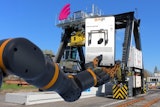Pines Technology’s newest Model 250 Heavy Duty CNC bender is a powerful automatic precision system for fast, repeatable bending of tube and pipe up to 10-inch diameter. Providing fast set-up and changeover advantages, this giant bender has an advanced level of programming to deliver automated high performance and flexibility in tube and pipe bending operations. See all the photos here.
The giant Pines bender depends on a reliable automated system for loading, aligning and clamping so that the 10-inch diameter pipe is bent precisely and consistently. Motion in this automated loading system is provided by a servo motor and drive combination that utilize CD couplings from Zero-Max tosynchronize and balance motion.
High Level System Performance Owed to Company Origins as a Pioneer and Global Leader in Tube and Pipe Bending Technology
Long term dependability of these automated Pines benders -- and the loading system in particular -- are a few of many design features developed by Pines over the years. Pines was the first to offer a fully automatic CNC bender, design a vertical compression bender, hot bend titanium tubing successfully, and provide boost bending techniques to minimize wall thinning. Besides identifying itself as the world’s finest tube bending and end forming equipment manufacturer, Pines provides a complete range of bend tooling and accessory options.
The focus here is on the loading system, its motion capabilities and the influence of Zero-Max couplings on the loads and forces experienced. Because these systems are designed for many years of operation with little or no maintenance, every component,especially the couplings, is key to the system’s reliability and longevity.
The design challenge for the loader system of this size was to come up with a method that would ensure smooth, synchronous motion. The design configuration had to be simple enough to allow for disassembly after initial testing in Pines’ manufacturing plant, then reassembled for actual operation in the customer’s overseas production facilities.
While the actual pipe bending operation is hydraulically powered, the loading system is driven by an electrically powered Yaskawa servo motor (SGMPH-08A1E41D) and Stober gearbox (K202VNO690-MT10) with a reduction rate of 69.43:1.With a travel distance of 76 inches, this loading system pushes, aligns and clamps tube weighing up to 1.5 tons as it progresses through the bending cycle.
To handle this motion, a set of four tip-up armsin the loader isolates a single tube from the load rack and deposits it on feed rolls located at the end of each traverse arm. The four traverse arms move the tube into position for the bending machine carriage to grasp the tube. These four traverse arms must move simultaneously to transport the heavy tube to its desired position for bending.
Pines design engineers determined the best way to achieve this motion was using a single servo motor connected to a gearbox. The load position varies with the tube OD and bend radius so the servo motor, with help from the CD couplings, are used to precisely position the traverse arms. Floating Shaft CD couplings connect and span the distance from the gearbox to the traverse arms and engage with a pinion gear that engages the racks on the traverse mechanisms.
Loader Traverse Mechanism Moves Pipe Weighing up to 1.5 Tons Synchronized with a Servo Motor and CD Coupling Connection
This design reflects Pine’s top-notch engineering to achieve a robust system that operates quickly for its size handling heavy loads and operating dependably for many years with minimal maintenance. Actual maximum shaft speed of the traverse mechanism is 70 rpm for a maximum linear speed of 880 inches a minute. The maximum motor/gearbox torque is 907 lb/in of continuous torque.
“By using Zero-Max’s CD coupling floating shaft models, we achieved the needed smooth, synchronous motion for the traverse arms,” reported Tim Kreja, new products manager for Pines Technology. “The CD couplingsallow for a very high degree of misalignment without binding or deterioration. This is very important in a system of this size and the forces experienced. Using the CD couplings also allowed us to use off-the-shelf, standard products instead of having to design and manufacture custom shaft components for this very large bender application.
Floating Shaft CD Coupling Is a Zero Backlash Spacer Coupling Design
Ideal for Pines Technology’s giant bender application, the floating shaft CD coupling is a zero backlash and torsionally stiff spacer coupling. It has many of the best features of other couplings with an important exception – its patented composite disc pack design.
While the CD coupling transmits torque similar to any conventional coupling, it does a better job of handling the misalignment forces that come into play in this application. It dampens backlash and shock without the coupling fatiguing. It accomplishes this through the patented unique open arm disc design made of highly durable composite disc material. This design absorbs and cushionsmisalignment forces and backlash that may occur from the servomotor’s intermittent motion. Also, the CD coupling provides excellent support for the floating shaft component with very little radial load on the connected equipment and bearings.
Each loader uses one CD Double Flex coupling and three CD Floating Shaft Double Flex couplings of various lengths. For assembly, after initial alignment and anchoring of the loader components, the floating shaft couplings are bolted in place to join the loader segments. Then the motor/gearbox assembly is installed with the final attachments made to the CD coupling. At this point, the loader is test operated manually to verify that there is no binding or undue loading on the couplings.
“The assembly process of the coupling components is relatively simple,” reported Mr. Kreja. “They are maintenance free, so they don’t require any service during operation. With the expected service load for this system, the couplings should last 10 or more years. We know about Zero-Max coupling reliability. We have used their Servo Class couplings to connect servo motors for many years. We have always been happy with the brand quality and performance. When our engineering staff saw the need for larger, more robust couplings for the giant Pines benders, they contacted Zero-Max for assistance and went with their CD couplings.”
For more information visit www.pinestech.com.























